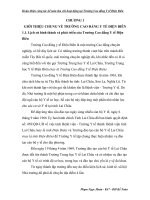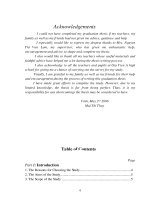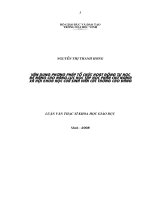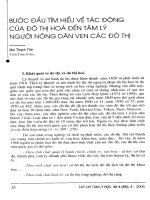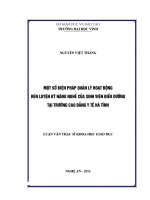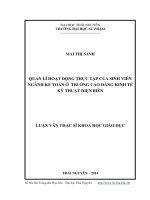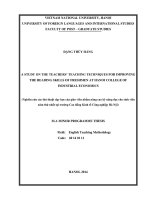Tìm hiểu về tác động của tiếng mẹ đẻ đối với việc học tiếng Anh của sinh viên dân tộc Thái tại trường Cao đẳng Y tế Thái Nguyên
Bạn đang xem bản rút gọn của tài liệu. Xem và tải ngay bản đầy đủ của tài liệu tại đây (1.22 MB, 61 trang )
VIETNAM NATIONAL UNIVERSITY, HANOI
UNIVERSITY OF LANGUAGES AND INTERNATIONAL STUDIES
FACULTY OF POST-GRADUATE STUDIES
*********************
CẦM THỊ KIỀU ANH
AN EXPLORATORY STUDY ON THE INFLUENCE OF THE MOTHER
TONGUE (L1) ON THE ENGLISH ACQUISITION OF THAI STUDENTS
AT THAI NGUYEN MEDICAL COLLEGE
Tìm hiểu về tác động của tiếng mẹ đẻ đối với việc học tiếng Anh
của sinh viên dân tộc Thái tại trường Cao đẳng Y tế Thái Nguyên
M.A. MINOR PROGRAMME THESIS
Field: English Teaching Methodology
Code: 60140111
Hanoi - 2014
VIETNAM NATIONAL UNIVERSITY, HANOI
UNIVERSITY OF LANGUAGES AND INTERNATIONAL STUDIES
FACULTY OF POST-GRADUATE STUDIES
*********************
CẦM THỊ KIỀU ANH
AN EXPLORATORY STUDY ON THE INFLUENCE OF THE MOTHER
TONGUE (L1) ON THE ENGLISH ACQUISITION OF THAI STUDENTS
AT THAI NGUYEN MEDICAL COLLEGE
Tìm hiểu về tác động của tiếng mẹ đẻ đối với việc học tiếng Anh
của sinh viên dân tộc Thái tại trường Cao đẳng Y tế Thái Nguyên
M.A. MINOR PROGRAMME THESIS
Field: English Teaching Methodology
Code: 60140111
Supervisor: NGUYỄN HUY KỶ, PhD
Hanoi - 2014
i
DECLARATION
I, hereby certify that the thesis entitled „An exploratory study on the influence of
the mother tongue (L1) on the English acquisition of Thai students at Thai Nguyen
Medical College‟ is the result of my own research in the fulfilment of the requirement for
the Degree of Master of Arts of the Faculty of Post Graduate Studies, University of
Languages and International Studies, Vietnam National University, Hanoi.
Hanoi, 2014
Researcher
Cam Thi Kieu Anh
ii
ACKNOWLEDGEMENTS
First and foremost, I would particularly like to express my deepest gratitude to my
supervisor, Dr. NGUYẾN HUY KỶ for his precious advice, remarkable, suggestions, kind
guidance and careful correction.
Next, I would like to acknowledge all my teachers at University of Languages and
International Studies, Vietnam National University, Hanoi, especially those who are
working at the Faculty of Post - Graduate Studies for their interesting lectures which
enable me to gain a great deal of theoretical knowledge and practical experience.
I am also indebted to all the students and teachers at Thai Nguyen Medical College
for their cooperation and participation in this study.
Last but not least, my heart-felt gratitude goes to my family for their
encouragement and support during the process of study.
iii
ABSTRACT
English language teaching in a non-native environment has experienced a variety of
obstacles, one of which is the interference of English learners‟ mother tongue. The
impediment is doubled when English is taught in a multi-lingual environment like
Vietnam, and this fact forces Vietnamese instructors of English to seek ways of teaching
their cohort of minority students effectively. In an attempt to improve of English language
teaching in Vietnam, this thesis investigates the possible impacts of Vietnamese Thai on
the English written production of Thai students at Thai Nguyen Medical College, with a
detailed contrastive analysis of English and Vietnamese Thai which English teachers can
use in their practice. The study employed a written production questionnaire, which has
been widely accepted as a tool for data collection in an interlanguage study. The results
suggest that Thai non-English major students heavily rely on their mother tongue in their
English writing. Several suggestions for minimising the influences of Thai learners‟
mother tongue on their English production are provided.
iv
LIST OF ABBREVIATIONS
1. L1= Mother tongue or first language
2. L2= Foreign language or second language
3. E = English
4. E
1
E
n
= English example 1….n
5. T = Vietnamese Thai
6. T
1
…T
n
= Thai example 1….n
7. E
s
= English sentences produced by the participant
v
LIST OF TABLES
Table1.1. English and Thai types of verbs 6
Table 1.2. English and Thai types of words following a verb 7
Table 1.3. English and Thai use of adjectives and adverbs 7
Table1.4. Formation of tenses in English and Thai 8
Table1.5. Subject-verb relation in English and Thai 9
Table1.6. Negation in English and Thai 9
Table1.7. English and Thai nouns 11
Table1.8. English and Thai articles 12
Table1.9. English and Thai word order 14
Table 1.10. Comparison of errors and mistakes 16
Table1.11. Dušková’s L1-transferred error classification 18
Table1.12. Keshavarz’s L1-transferred error taxonomy 18
Table1.13. Possible L1 interference of the Thai learners of English 19
Table 3.1. Summary of the total number of errors 25
Table 3.2. Errors in verbs 26
Table 3.3. Errors in nouns 29
Table 3.4. Errors in articles 30
Table 3.5. Errors in prepositions 32
Table 3.6. Errors in word order 35
vi
TABLE OF CONTENTS
DECLARATION i
ACKNOWLEDGEMENTS ii
ABSTRACT iii
LIST OF ABBREVIATIONS iv
LIST OF TABLES v
PART A - INTRODUCTION 1
1. Rationale 1
2. Aims of the study 2
3. Research questions 2
4. Scope of the study 3
5. Significance of the study 3
6. Research methods 3
7. Thesis structure 3
PART B - DEVELOPMENT 5
CHAPTER 1: LITERATURE REVIEW 5
1.1. The Thai people and language in Vietnam 5
1.1.1. The Thai people 5
1.1.2. The Thai language 5
1.2. A contrastive analysis of Thai and English 6
1.2.1. Verbs 6
1.2.2. Nouns 10
1.2.3. Articles 12
1.2.4. Prepositions 13
1.2.5. Word order 13
1.3. Distinction of errors and mistakes 15
1.3.1. Errors 15
1.3.2. Mistakes 16
1.3.3. Distinction of errors and mistakes 16
1.4. Language transfer and L1 transfer in L2 acquisition 17
vii
1.5. Possible errors committed by Thai students in their learning of English 18
CHAPTER 2: METHODOLOGY 20
2.1. Research setting 20
2.1.1. An overview of the research site 20
2.1.2. The students 20
2.1.3. Learning materials 21
2.2. Participants 21
2.3. Data collection instrument 22
2.4. Data collection procedure 22
2.5. Data analysis procedure 22
CHAPTER 3: RESULTS AND DISCUSSION 24
3.1. Data analysis and discussion 24
3.1.1. Identification of interlingual errors 24
3.1.2. Description and discussion of identified errors 24
3.2. Major findings 35
PART C - CONCLUSION 37
1. Recapitulation 37
2. Conclusions 37
3. Pedagogical implications 38
4. Limitations and suggestions for further studies 39
4.1. Limitations 39
4.2. Suggestions for further study 40
REFERENCES 41
APPENDICES I
1
PART A - INTRODUCTION
This part presents the rationale, the aims of the study, the research questions and the
methods used to achieve the research objectives. The scope, significance and the
organization of the study are also stated.
1. Rationale
Today, English becomes an important and influential language worldwide, with
over 300 million native speakers and between 400 and 800 million non-native users
(Manivanan, 2006). It is considered as a tool for international communication and world-
wide data sharing. English proficiency is of significance for individuals since it enables
them to update their knowledge and share their practices and experiences or seek help from
other people around the world in case obstacles arise at study and work. English, thus, can
“contribute to students‟ personal, linguistic, social, and cultural development” (Canh Le,
2004, p.167).
Apparently, everybody would like to learn English; however, not so many people
can study English well (Tam Nguyen, 2011) since L2 learning depends on various factors.
Perhaps, of all the difficulties shared by Vietnamese learners of English, e.g. lack of
supportive learning environment, lack of infrastructure and facilities, etc., minority
students have suffered distinctive obstacles in their learning of English, one of which is
teachers‟ low English proficiency and low proficiency of the Thai language, which cause
difficulties in explaining new grammar terms and language areas to the Thai students.
Additionally, students‟ knowledge gaps resulting from their lower levels of learning and
learning both Vietnamese and English simultaneously cause lots of difficulties for Thai
learners of English.
Actually, the above hindrances could be solved if finance is granted and teachers‟
qualification is improved, but there exist impediments–the linguistic differences between
L1 and L2-cannot be alleviated even with a complete disappearance of the above obstacles.
This claim is strongly supported by L2 researchers who found that L2 learners heavily rely
on their L1 in their L2 learning (Dechert, 1983; Ellis, 1997). Specifically, George (1972)
found that one-third of the deviant sentences from L2 learners could be attributed to
language transfer. In other words, the L1 interference, which causes interlingual errors,
2
rooted from the differences of the two languages. A distant relation between the L1 and L2
could cause negative transfersinto language learners‟ L2 acquisition, which hampers
language learners‟ intelligibility. Research suggests that negative transfers from L1 into L2
does happen to Vietnamese learners of English, whose L1 is very similar to Thai (Hao
Cao, 2000; Dat Huu, Doi Tran, & Lan Đao, 1998; Huyen Nguyen et al., 2004). The above
discussion suggests that the interference of Thai learners‟ L1 into their English learning is
definitely existent.
There might be a variety of aspects which are different between the two languages,
but Saporta (1966) argues that the grammar of the learners‟ L1 plays a crucial role on their
discovery of a new language. Supporting this view, Corder (1969) argues that learning a
new language is a simpler task, where language learners only need to find out if the
systems of the new language are the same or different from those of the language they
know, and if different, what their nature is. Owing to the great importance of L1 grammar
into L2 learning, this research aims to investigate the relationship of Vietnamese Thai and
English and its possible effects on Thai learners of English with respect to grammatical
aspects only.
2. Aims of the study
In an attempt to improve the quality of teaching English to the Thai students at Thai
Nguyen Medical College, this study aims:
1. To investigate how the Thai students‟ L1 might affect their learning of English.
2. To implement a contrastive analysis to figure out the similarities and differences
between the Thai grammar and its English counterpart.
3. To offer suggestions for overcoming negative linguistic transfers that the Thai
learners of English may encounter in their learning of English.
3. Research questions
The present research aims to answer the following three questions:
1. What are the most common differences between the Thai and English grammar at
the word and sentence level?
3
2. How may these differences affect the Thai students‟ English learning at the tertiary
level?
3. What teaching strategies could minimise the effects of the Thai students‟ L1
interference in their English learning?
4. Scope of the study
Due to the nature of a minor study, the scope of the present study is limited to a
small number of students at Thai Nguyen Medical College, and its very focus is on the
impacts of Thai learners‟ L1 on their English written production at the word and sentence
level only.
5. Significance of the study
As discussed previously, foreign language learners often heavily rely on L1 in their
L2 learning; and the greater the differences between L1 and L2, the more errors foreign
language learners could make in their L2 production. In other words, language learners‟ L1
could be a major resource of their L2 errors. It is, thus, of great significance to carry out an
investigation to figure out students‟ possible L1 transfer into their L2 learning process.
This could be the strength to inform language teachers of the language areas that their
students could encounter difficulties in the process of learning and teaching so that they
could have appropriate adjustments to their lesson plans and seek strategies to help their
students overcome such negative transfers.
6. Research methods
This study employed a qualitative approach, and data were collected via a written
production questionnaire which was designed to examine whether the Thai students at Thai
Nguyen Medical College suffered from L1 transferred in their learning of English.
7. Thesis structure
Part A - Introduction
This part presents basic information like the rationale, aims, research questions,
scope, significance, methods, and organization of the study.
Part B - Development
4
a. Chapter 1: Literature Review
The chapter provides an overview of the Thai people, the Thai language and a
contrastive analysis of English and Thai, which serves as a theoretical basis for
the whole study.
b. Chapter 2: Methodology
The chapter includes an overview of the approach used in conducting the study.
It also provides a thorough description of the data collection procedure and the
analytical procedure.
c. Chapter 3: Result and Discussion
The chapter reports the findings of the study and discusses the prominent
aspects to answer the research questions stated in the previous chapter.
Part C - Conclusion
This part states the conclusions of the major findings, recommendations, limitations
of this research, and suggestions for further studies.
5
PART B - DEVELOPMENT
CHAPTER 1: LITERATURE REVIEW
This chapter establishes the theoretical background for the study. It first provides an
overview of the Thai and their language then presents a contrastive analysis of English
and Thai, the definition of ‘errors’ and ‘mistakes’ and their distinction followed a
prediction of the errors likely committed by Thai learners of English.
1.1. The Thai people and language in Vietnam
1.1.1. The Thai people
The Thai people originated from China (Wyatt, 2003) and emigrated to Vietnam
between the 7
th
and 13
th
century (Quang Mai, 2004). The history and the language of the
Vietnamese Thai people have a common origin with the Thai group in South China, Laos,
Thailand and Burma. The number of the Vietnamese Thai people is more than one million,
and they mainly populate the South West of the Red River. Other groups belonging to this
language family include the Giay, Lu, San Chay, Tu Di and Bo Y.
Vietnamese Thai communicate with each other in their own language but they also
consider Vietnamese as a second and necessary language that they need to acquire.
Although tourism and modern life have been introduced to Thai people from the 1990s,
Thai people have maintained their traditional culture, customs and their own language as
well. Moreover, they also know how to use their language advantages in cultural exchange,
tourism and foreign trade to ensure a better life for themselves and the maintenance of their
culture. The Thai have their own Sanskirt-style writing system, so they have many ancient
written works on their history, traditions, customary laws, and literature.
1.1.2. The Thai language
The Thai speak Thai that belongs to the original Thai-Kadai language system. In
this group, there are the Thai language (Thailand), the Lao language (Laos), the Shan
language in Myanmar and the Choang language in the southern China. In Vietnam, the
languages of eight ethnic minorities (Bo Y, Giay, Lao, Lu, Nung, San Chay, Tay and Thai)
are classified in the Thai language family.
6
Vietnamese Thai is placed into the community sector of the Tay-Thai language
family, including many branches, and each of which is divided into several groups, with
different names depending on the locality. However, the most obvious and common of all
is the division of the Thai people with two branches: the Black Thai and White Thai (Tay
Don and Tay Dam). In fact, Vietnamese Thai, Laos and Thailand people have a common
origin and speak Thai-Kadai languages.
The original language of the Thai people has always been preserved and handed
down from generation to generation. Vietnamese Thai children are taught in their native
language, and they will be learning Vietnamese at their school age. The Vietnamese Thai
people are one of a few Vietnamese ethnic minorities who had their own writing system.
1.2. A contrastive analysis of Thai and English
It is easily recognised that two languages often contain a great number of
similarities and differences at different level and in various areas. This section only
outlines major similarities and differences between Thai and English with respect to their
verbs, nouns, articles, prepositions and word order.
1.2.1. Verbs
Thai and English originate from different language families, but their verbs share a
number of similarities, especially the types of verbs that the two languages possess. These
similarities between the two languages are summarised in the following table:
Table1.1. English and Thai types of verbs
Types
Languages
Intransitive
Transitive
Ditransitive
English
+
+
+
Thai
+
+
+
Note: ‘+’ means ‘existent’
Examples:
S V
(E
1
): He swam.
(T
1
):
S V O
(E
2
): John bought a textbook.
7
(T
2
):
S V O
1
O
2
(E
3
): Mary gave me a pen.
(T
3
):
Furthermore, English and Thai are similar with respect to a variety of types of word
to follow a verb:
Table 1.2. English and Thai types of words following a verb
Types
Languages
Noun
Pronoun
Adverb
Adjective
English
+
+
+
+
Thai
+
+
+
+
Note: ‘+’ means ‘existent’
Examples:
(E
1
): They bought fruits.
(T
1
):
(E
2
): He likes her.
(T
2
):
(E
3
): He speaks naturally.
(T
3
):
(E
4
): He feels tired.
(T
4
):
However, Thai adjectives can occur not only as post-modifiers of nouns but also as
post-modifiers of verbs, whereas English adverbs always go with verbs.
Table 1.3. English and Thai use of adjectives and adverbs
Notion
Languages
Followed by adverbs
Followed by adjectives
English
+
-
Thai
+
+
Note: ‘+’ means ‘existent’; ‘-’ means ‘nonexistent’
Examples:
(E
1
): The old man started the story
slowly.
8
adverb
(T
1
): (Po thảu coi khay quãm tỗ)
(E
2
): He speaks very
fast.
adverb
(T
2
): (Mẵn pák vẵn hênh)
adjective
Another big difference is that English verbs receive morphological marks for tenses
while words are normally added to the verbs or the ending of sentences to show tenses in
Thai, which is summarised in the table below:
Table1.4. Formation of tenses in English and Thai
Notion
Languages
Morphological changes
Adding words
English
+
+
Thai
-
+
Note: ‘+’ means ‘existent’; ‘-’ means ‘nonexistent’
Examples:
(E
1
): Every year, he
BUYS
a new bag. (Simple present)
(T
1
):
(Mỏi pì, mẵn
XỰ
khảng thồng nưng)
(E
2
): Last month, he
BOUGHT
a new bag. (Simple past)
(T
2
):
(Bườn cón, mẵn
XỰ
khảng thồng nưng lẹo)
(E
3
): She
WILL come
here next month.(simple future)
(T
3
):
(Mẵn
CHÍ MÃ
nỉ nẳng bườn máư)
The agreement between a subject and its verb is another big difference between
Thai and English. In Thai, there are no such a relationship between a subject and its verb in
a sentence, but it is a marked grammatical aspect in English. The table and instances below
clearly state this contrastive feature between the two languages:
9
Table1.5. Subject-verb relation in English and Thai
Notion
Languages
Subject-Verb agreement
English
+
Thai
-
Note: ‘+’ means ‘existent’; ‘-’ means ‘nonexistent’
Examples:
Plural
(E
1
): My friends
play
chess
everyday
(T
1
):
(Pững xính cu khỏi
ỉn
phại
chu mự)
Singular
(E
2
): He
plays
chess
every day.
-S
(T
2
):
(Mẵn
ỉn
phạị
chu mự)
Plural
(E
3
): Her parents
watch
dancing
every night.
(T
3
):
(Ải ễm mẵn
lẽ
xẽ
chu cữn)
Singular
(E
4
): She
watches
dancing
every night.
-ES
(T
4
):
(Mẵn
lẽ
xẽ
chu cữn)
The negation in English is also far different from that in Thai. English uses
auxiliaries plus the word ‘not’ to form a negative form while the negation in Thai is formed
by adding a negative words like (báu’, ‘hễ’) (which are equivalent of „not‟ in
English) in front of a verb:
Table1.6. Negation in English and Thai
Notation
Languages
Use of auxiliaries plus
NOT
Adding negative words
only
10
English
+
-
Thai
-
+
Note: ‘+’ means ‘existent’; ‘-’ means ‘nonexistent’
Examples:
(E
1
): He
didn‟t do
his homework yesterday.
Aux. +
NOT
(T
1
):
(Mự ngoã mẵn báu dệt bãi tợp nẳng hưỡn)
BÁU + V
(E
2
): She
hasn‟t finished
her homework.
Aux. + NOT
(T
2
):
(Mẵn
hễ dệt
lẹo bãi tợp)
HỄ + V
(E
3
): Mary
doesn‟t want
to drink anything.
Aux. + NOT
(T
3
):
(Mary
báu é
kìn xằng xắc nỏi)
BÁU + V
Another difference between the two languages is the absence of the particle ‘to’ in
case two verbs are juxtaposed and the omission of the copula verb „to be‟ in front of an
adjective and a noun.
For examples:
(E1): My father wants to buy a new pot.
(T
1
):
( Ải cù é xự khảng mỏ máư nưng.)
(E2): I am tired.
(T
2
):
(Cù nưới)
1.2.2. Nouns
Along with verbs, nouns are a major part of speech of both English and Thai.
Despite sharing the same functions in a sentence and usually being made up of one, two or
occasionally several words, the noun in both languages have lots of differences. The
following table summarise the differences between English nouns and Thai counterparts:
11
Table 1.7. English and Thai nouns
Categories
Languages
Countable
nouns versus
mass nouns
Morphological
marks for
plurals
Agreement
with pre-
modifiers
Classifiers in
front of
nouns
English
+
+
+
-
Thai
-
-
-
+
Note: ‘+’ means ‘existent’; ‘-’ means ‘nonexistent’
The most striking point to notice is that English nouns are divided into „countable
nouns‟ (e.g., book, pen, umbrella, and computer) and „uncountable nouns‟ or „mass nouns’
(e.g., water, milk, salt, and rice)‟. By contrast, Thai has no such classification. This
distinction results in many other differences between English and Thai nouns. Normally,
morphological marks are added to English singular nouns to establish their plural form or
change into a different form to show plural, while that of the Thai language is created by
adding the words like (‘pững’) in front of the single form. For example:
ENGLISH
THAI
Singular
Plural
Singular
Plural
a book
books
pặp xừ nưng
pững pặp xừ
an old book
old books
pặp xừ cáu nưng
pững pặp xừ cáu
one child
children
đếch nọi nưng
pững đếch nọi
a bracelet
bracelets
pók khèn nưng
pững pók khèn
Another distinctive feature of English nouns is that they must agree with its pre-
modifiers, that is, the use of pre-modifiers in front of an English noun impacts on the kinds
of noun to be used and its form. Conversely, this does not occur in Thai.
12
Additionally, the Thai language also has some characteristics that do not exist in English
such as the use of classifiers in front of a noun. For instance:
ENGLISH
THAI
a knife
(MẠK mịt nưng)
these cows
(pững TỒ ngũa nị)
three spoons
(sàm CẢN buống nị)
1.2.3. Articles
The table below illustrates the difference between Thai and English regarding this
category:
Table1.8. English and Thai articles
Articles
Languages
Indefinite „a/an‟
Definite „the‟
English
+
+
Thai
-
-
Note: ‘+’ means ‘existent’; ‘-’ means ‘nonexistent’
Thai has an equivalent translation of English indefinite articles „a/an‟, but it does
not always satisfy the characteristics of its English counterparts: (1) to indicate a specific
person/thing that is unfamiliar to the addressee or is first-mentioned and (2) to indicate a
whole class of entities (Jacobs, 1995). They are added before a noun. The Thai
counterparts of English indefinite articles („nưng/điều‟) can be used for both
specific and generic cases, but they are added after a noun.
Example 1:
(T):
(Cữn nị cù hền bả lák nưng nẳng cuồng xuồn hưỡn cù)
(E): Last night, I saw a strange man in my garden.
Example 2:
(T):
(Tồ quãi điều lỏ men chương khòng chũa hưỡn)
13
(E): A buffalo is the property of the whole family.
As regards the definite article ‘the’ of English, it appears that there is not an
equivalent translation in the Thai language. Instead, it is omitted in Thai.
Example 1:
(T):
(Mững àu pặp xừ nẳng Ma-ry lẹo hễ?)
(E): Did you get the book from Mary?
Example 2:
(T):
(Khảng đàng hưỡn nặn mẵn xự pì cài chí đảy tã xi xìa)
(E): The house that he bought last year need to be repainted.
1.2.4. Prepositions
Similar to English, Thai also has a category of word which is similar to English
prepositions. This category can be considered to be the Thai equivalents of English
prepositions, but a preposition in the their L1 may be equivalent to a variety of English
prepositions, e.g. ‘cuồng’-‘in, inside’, ‘nọk’ - ‘out, outside, out of‟, and
‘càng’- ‘among, between, within, among, between, in the middle of, in the midst of’.
As a result, in the mind of the Thai learners of English, many different English
prepositions can be used when their English production requires a preposition. They might
confusion over their selection of an appropriate preposition for their sentences. The simple
example below presents this point:
(T):
(Khỏi/ cù vạy pặp xư
nẳng tễnh
khảng pãn
kẽm
táng
(E): He put the book
on, upon,
above,
over,
on top of,
atop
the table
by,
near next
to, close
to, beside
the window.
The example above suggests the difficulties and confusion regarding the use of English
prepositions that the Thai learners of English may encounter.
1.2.5. Word order
14
English and Thai share a basic word order „subject-verb-object (S-V-O)‟ and their
dominant position is that a subject lies before a predicate. Similarly, when the copula verb
„to be‟ is used to link a noun to another, its position can be changeable.
Examples:
(E
1
): Ms. Linh
is
my teacher of English.
(E
2
): My teacher of English
is
Ms. Linh.
(T
1
): .
(À Linh
lỏ
à xãy quãm Anh khòng khỏi / cù)
(T
2
):
(À xãy quãm Anh khòng khỏi / cù
lỏ
à Linh)
Despite those similarities, English and Thai have many differences. The most
striking variance between the two languages is the possible position of the elements of a
noun phrase. An English adjective precede the noun which it modifies, whereas Thai
possesses a reverse word order, stated as follows:
Table1.9. English and Thai word order
Categories
Languages
Possessive Adj. + N
Determiner + Adj. + N
English
+
+
Thai
-
-
Note: ‘+’ means ‘existent’; ‘-’ means ‘nonexistent’
Examples:
(E
1
): His
Dog is quite friendly.
Poss. Adj.
N
(T
1
): .
Tồ mà
khòng mẵn ín đù hênh
N
Poss. Adj.
(E
2
): He has a lot of
good
books.
Adj.
N
(T
2
):
Mẵn mĩ lài
pặp xừ
muôn.
N
Adj.
The positions of English adverbials are more flexible than those of Thai, but they
are basically similar to each other. For instance, English adverbials of manner may take at
15
the beginning, middle or end of the sentence whereas those of Thai only take at the end of
the sentence. Similarly, both Thai and English adverbials of time, direction and frequency,
and purpose share their position in a sentence. Let‟s look at the examples below:
(E
1a)
: John does his homework carefully.
adv. of manner
(T
1a
): . (Jôn dệt bãi tập mã hưỡn đì hênh)
adv. of manner
(E
1b
): Carefully, he does his homework.
adv. of manner
(T
1b
): Non-existent
(E
1c
): He carefully does his homework.
adv. of manner
(T
1c
): Non-existent
(E
2a
): He was learning at 9 last night.
adv. of time
(T
2a
): . (Mẵn nhẵng ép xừ mưa cảu chỡ cữn nị)
adv. of time
(E
2b
): At 9 last night, he was learning.
adv. of time
(T
2b
): .(Mưa cảu chỡ cữn nị mẵn nhẵng ép xừ)
adv. of time
(E
3
): She goes to school in a hurry.
adv. of direction
adv. of manner
(T
3
): . (Mẵn pày họt trưỡng phạo phũ)
Adv. of direction
adv. of manner
1.3. Distinction of errors and mistakes
1.3.1. Errors
In English language teaching, numerous definitions have been given to the notion
of „error‟. Corder (1973) defined an error as a breach of the code, and they deviate from
what is regarded as the norm. In the words of James (1998), a language error is an
unsuccessful bit of language. Similarly, an error is “the flawed side of the learner speech or
writing, they are parts of conversation or composition that deviates from selected norms”
(Dulay, Burt, & Krashen, 1982, p.138).
In short, an error is a piece of language produced by a non-native speaker of a
foreign language, which can cause failures or unintelligibility in communication.
16
1.3.2. Mistakes
Like the notion of „error‟, a mistake is also defined in lots of different ways. In the
words of Corder (1967), mistakes are defined as adventitious, random errors in
performance due to memory lapses, physical states, etc., of which the speaker may be
immediately aware. Similarly, a mistake is an inconsistent deviation that is sometimes the
learner „gets it right‟ but sometimes wrong (Norrish, 1983). According to Richards et al.
(1984), a mistake is an inappropriate use of a piece of language made by a learner when
writing or speaking and which is caused by lack of attention, fatigue, carelessness, or some
other aspect of performance.
To sum up, a mistake is a linguistic failure, which might occur in a particular
situation but may not appear in another one, and language learners could overcome them if
attention is paid.
1.3.3. Distinction of errors and mistakes
Both errors and mistakes can be seen as linguistic failures, but linguists and
scholars reach agreement that they are different in many aspects. Their differences are
illustrated in the table below:
Table 1.10. Comparison of errors and mistakes
ERRORS
MISTAKES
Frequency
- Consistently (Norrish, 1983;
Worth, 1987)
- Inconsistently or repeatedly
(Norrish, 1983; Worth, 1987)
Cause
- Incomplete knowledge (Richards
et al., 1984)
- Lack of attention, fatigue,
carelessness, or some other aspect
of performance (Richards et al.,
1984)
- Defects in knowledge (Corder,
1969)
- Memory lapses and physical states
and others of the like (Corder,
1967)
State
- Systematic (Corder, 1967;
Norrish, 1983; Worth, 1987)
- Adventitious and random (Corder,
1967; Norrish, 1983; Worth, 1987)
Significance
to language
learning
- Significant (Corder, 1967)
- Not significant (Corder, 1967)
It can be concluded a mistake refers to the failures to use the language system
correctly caused by some factors such as carelessness, memory lapses, and physical


